Australia's Parliament House
This in-depth look at Australia's Parliament House investigates why Canberra was chosen to be the nation's capital and why we needed a 'new' Parliament House. It includes the design, site and symbolism of the building.
Australian Parliament House and Provisional (Old) Parliament House
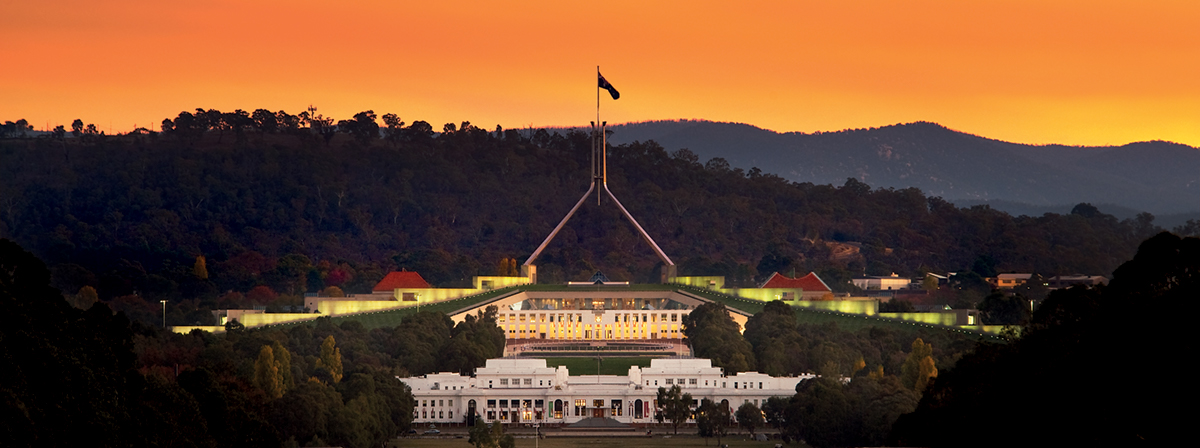
John Gollings
Description
Provisional Parliament House – also known as Old Parliament House – is where Parliament met in Canberra between 1927 and 1988. It is the smaller, white building visible at the bottom of this image. Parliament moved into a new building, Australian Parliament House, in 1988. The new building is roughly 300 metres away from the old building. In the centre of this image, the much larger Australian Parliament House is visible, with its distinctive flag mast and the Australian flag.
Copyright information
For permission to use this image, contact the copyright holder.
Parliament House is located on Capital Hill, Canberra. Prior to the arrival of Europeans in Australia, this region had a range of important ceremonial sites for local Aboriginal peoples. In Walter Burley Griffin's plan for Australia's national capital, this hill was the most prominent location.
Prime Minister Malcolm Fraser broke the ground to officially start construction on Capital Hill on 18 September 1980. Parliament House was opened by Her Majesty Queen Elizabeth II on 9 May 1988. It was the biggest building project undertaken in Australia since the construction of the Snowy Mountain Hydro-electric Scheme in the 1960s. Ten thousand people worked on the construction of the building, which is built almost entirely of Australian materials.
Parliament House is one of the largest buildings in the southern hemisphere and it cost $1.1 billion to build. It is 300 metres long and 300 metres wide, has a floor area of more than 250,000 square metres and has more than 4,500 rooms. When Parliament meets 4,000 to 5,000 people work in the building.
Choosing a federal capital
Naming of Canberra ceremony, 12 March 1913
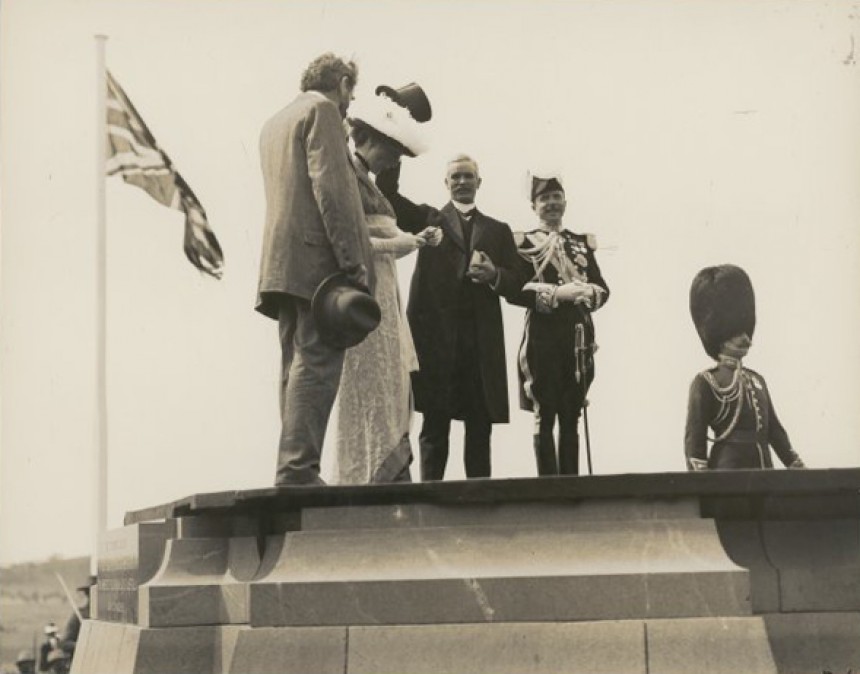
National Library of Australia, VN4503893
Description
This photograph captures the official naming ceremony of Australia’s national capital on 12 March 1913. Lady Denman, wife of the Governor-General, stood on a platform to declare that the capital of Australia would be called Canberra. Prime Minister Andrew Fisher is seen waving his hat in celebration, while Governor-General Lord Denman and other dignitaries look on. A British flag flies on a pole behind the group.
Copyright information
You may save or print this image for research and study. If you wish to use it for any other purposes, you must declare your Intention to Publish.
In 1902 the search for a suitable site for a new capital began. At the time it was believed people function better in a cool climate, and sites with cool climates were favoured. The perfect site needed to have an adequate water supply and provide a setting for a garden city. Thirty five sites were suggested, including Albury, Bathurst, Bombala, Dalgety, Orange and Tumut, before Parliament chose the Canberra region in 1908.
An international competition was held to design the new national capital. In 1912 it was announced entry number 29 from American architect Walter Burley Griffin had been selected as the winner. Construction of Canberra began the following year.
Plans for a permanent Parliament House stalled during World War I and, in 1921, the Australian Government decided to construct a provisional building. Designed by John Smith Murdoch, the first federal government architect, it was a modest and functional building with 184 rooms. Some people criticised its lack of grandeur, saying the building was not imposing enough for Parliament.
The need for a new Parliament House
The new Parliament House on Capital Hill replaced the provisional building. Always intended as a temporary home for the Australian Parliament, the provisional building remained in operation for 61 years. When it opened on 9 May 1927, there were 101 members of parliament. By the time the building closed, this number had more than doubled to 224.
Despite many additions and alterations, by 1988 the provisional building was completely inadequate for the needs of a modern Parliament. About 3,000 people were crammed into a space originally designed for several hundred.
In 1978, then Prime Minister Malcolm Fraser unveiled plans to build a new Parliament House to be opened in 1988, the bicentennial year of European colonisation. An international competition held to find a suitable design for the building attracted 329 entries. In 1980 it was announced a design by New York-based Mitchell/Giurgola & Thorp Architects had been chosen.
The new Parliament House has 6 times the floor space of the provisional building, now known as Old Parliament House, and is designed to last at least 200 years. On a sitting day it accommodates about 5,000 people.
At the opening of Parliament House in 1988, then Prime Minister Bob Hawke said, 'This building will become for our nation both the forum for our differences and the instrument of our unity. A building for all Australians, a Parliament reflecting the diversity of our entire society and responding to the needs of the whole community'.
Provisional (Old) Parliament House

Visit Canberra
Description
This building, Provisional Parliament House is also known as Old Parliament House. This was where the Australian Parliament met between 1927 and 1988. The flag pole of Australian Parliament House can be seen the background – Parliament moved to a new, larger building a few hundred metres away in 1988.
Copyright information
Contact the copyright holder for permission to reuse.
The design
The design is based on 2 huge curved walls, each 460 metres in length, which separate Parliament House into 4 main zones:
- The House of Representatives and offices on the eastern side.
- The Senate and offices on the western side.
- A central zone which includes ceremonial and public spaces.
- The executive government wing on the southern end of the structure.
The incorporation of the building into the landscape is a key element of the design. It is consistent with Walter Burley Griffin's vision for Canberra, which integrated the built and natural environment. Architect Romaldo Giurgola observed that Parliament House 'could not be built on top of the hill as this would symbolise government imposed upon the people. The building should nest with the hill, symbolically rise out of the Australian landscape, as true democracy rises from the state of things.'
One million cubic metres of earth and rock were removed from the site to make way for the building. The central zone of Parliament House was then built into Capital Hill. It was placed within the 2 curved walls and covered over with grass to recreate the shape of the hill.
The site
In Griffin's original plan for Canberra, Parliament House was to be built on Camp Hill, just below where it is now located. Griffin reserved the Capital Hill site for a ceremonial public building called the Capitol, which would celebrate the achievements of the Australian people. Its elevated position above Parliament House symbolised Parliament's accountability to the people, who 'oversee' their representatives.
However, Provisional Parliament House was built just beneath Camp Hill. It would need to be demolished if Griffin's plan was followed. The Australian Parliament considered both the Camp Hill and a lakeside site before agreeing to build Parliament House on Capital Hill.
Mitchell/Giurgola & Thorp's design pays tribute to Griffin's original vision. The flagmast traces the outline of the pyramidal 'Capitol' building from Griffin's competition drawings. The grassed roof allows people to stand above their elected representatives.
Griffin used the land formations around Canberra as the basis for his plan for the city and to define symbolic axes. These included a land axis that runs from Mount Ainslie through Capital Hill, the site of Parliament House. The central zone of Parliament House was placed in line with Griffin's land axis. It extends from the Forecourt to the ministerial wing, and links the people to the executive government.
The Senate and the House of Representatives are located on a line known as the legislative – law-making – axis. It crosses the land axis in the Members Hall at the very centre of the building beneath the Australian flag, visible through a glass skylight. This intersection is in the middle of the building. It symbolically brings together the different elements that make up Australian democracy – the people, the members of parliament and the government – under the unifying symbol of the flag.
Floorplan of Australian Parliament House
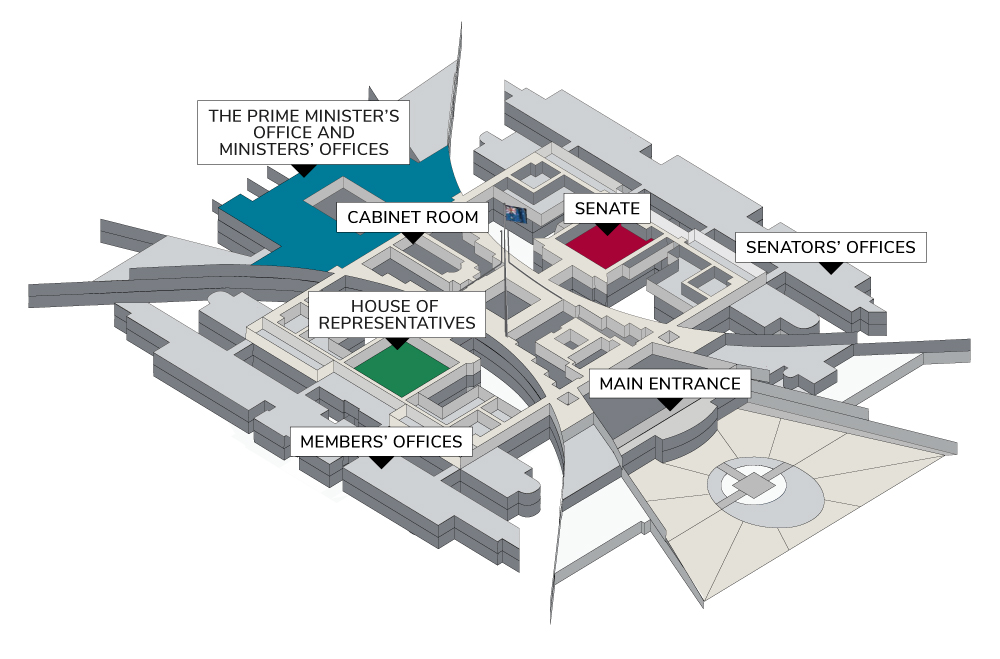
Parliamentary Education Office (peo.gov.au)
Description
Australian Parliament House has several main areas:
- At the north of the building is the main entrance.
- The House of Representatives and members' offices are on the east of the building.
- The Senate and senators' offices are on the west.
- The Executive wing is at the south. This is where the Prime Minister and ministers have their offices.
- The Cabinet room is to the north of the Prime Minister's office.
The floor plan shows that Parliament House is made up of 3 separate buildings joined together.
Copyright information
This work is licensed under a Creative Commons Attribution-NonCommercial-NoDerivs 3.0 Unported License.
You are free to share – to copy, distribute and transmit the work.
Attribution – you must attribute the work in the manner specified by the author or licensor (but not in any way that suggests that they endorse you or your use of the work).
Non-commercial – you may not use this work for commercial purposes.
No derivative works – you may not alter, transform, or build upon this work.
Waiver – any of the above conditions can be waived if you get permission from the copyright holder.
A place for the Parliament
The Senate and House of Representatives
The 2 curved walls in Parliament House separate the Senate and House of Representatives, a division that physically represents Australia's bicameral parliamentary system in which laws can only be passed if both houses agree.
The Senate and House are the largest rooms in the building. Members of parliament meet in these rooms to debate bills – proposed laws – and represent the people of their electorate or state/territory.
The House of Representatives
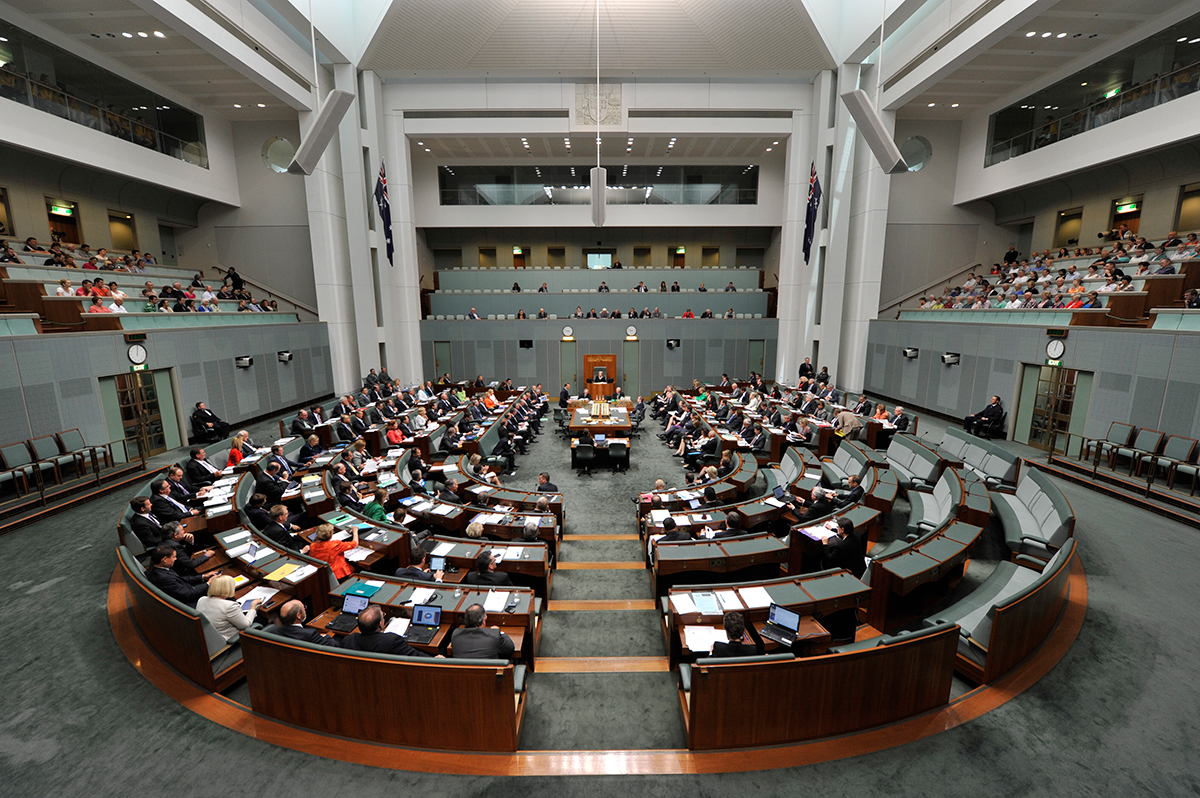
DPS Auspic
Description
The House of Representatives is a large room with green furnishings. The seats are arranged in rows around a large central table. There is a large chair at the open end of the U-shaped seats that is elevated above the other chairs where the Speaker sits. Members of the House of Representatives sit in the U-shaped seats. Members of the public and the press sit observing from the balconies above the House.
Copyright information
Permission should be sought from DPS AUSPIC for third-party or commercial uses of this image. To contact DPS AUSPIC email: auspic@aph.gov.au or phone: 02 6277 3342.
In both the Senate and House, the seats are arranged in rows in a horseshoe shape. This replicates the layout of Old Parliament House.
The Senate
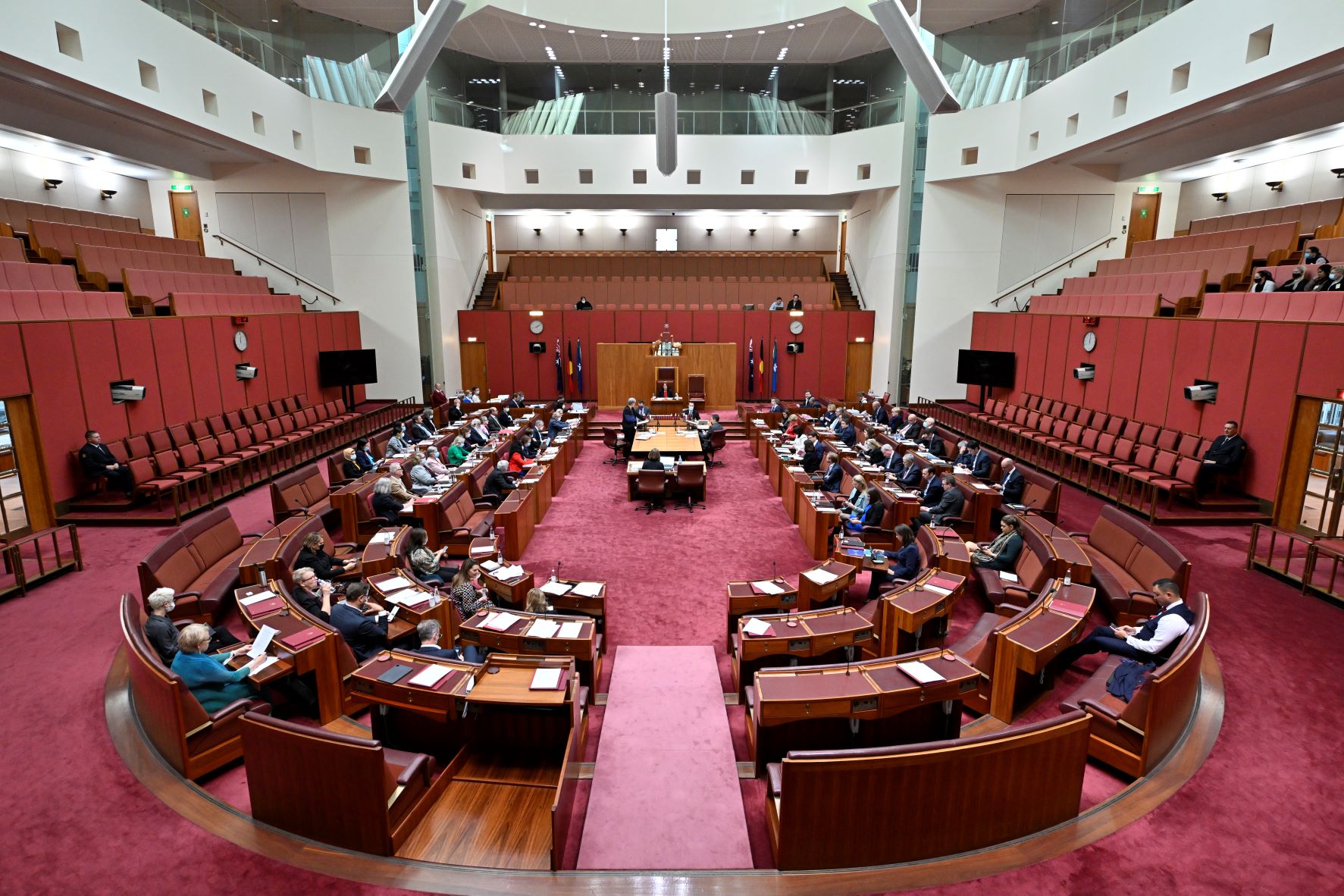
DPS AUSPIC
Description
The Senate is a large room with red furnishings. The seats and desks are arranged in rows in a U-shape around a large central table. There are 3 large chairs at the open end of the U-shaped seats that are elevated above the other chairs. The President of the Senate sits in one of these chairs. Senators sit in the U-shaped seats. Members of the public and the press sit observing from the balconies above the Senate
Copyright information
Permission should be sought from DPS AUSPIC for third-party or commercial uses of this image. To contact DPS AUSPIC email: auspic@aph.gov.au or phone: 02 6277 3342.
The colours of the rooms are based on those used in the British Parliament, with red for the Senate and green for the House. These traditionally rich colours have been adapted to reflect the Australian landscape – the green used in the House and the red in the Senate are similar to the grey-green and red ochre colours of the Australian landscape.
Each room has a distinctive architectural style. In the Senate, this is based on circles and ellipses. In the House, on angular shapes. The ceilings provide a striking example of this contrast. It can also be seen in the rooftops of both: the Senate has a circular roof and the House roof is angular. The rooftops are finished with red terracotta tiles. This is a reference to the red-tiled rooftops of many Australian homes.
Both rooms have large central roof skylights which let in natural light during the day, and at night glow to indicate Parliament is sitting. In Old Parliament House, a red light on the roof above the Senate and a green light above the House indicated when each was in session.
In both the Senate and House, the colours are a deeper shade at the floor level, which puts the focus on the participants. The colour gradually lightens as it gets closer to the ceiling, where it combines with the natural light from the skylight to give the space above each an airy, floating quality. The architects intended that this be a 'metaphor for a free and open society'.
In both the Senate and House of Representatives:
- Members of the government sit to the right of the Speaker (in the House) or the President (in the Senate), while members of the opposition sit to the left.
- Members of minor parties and independents sit on the curved benches of the horseshoe.
- There is a seating area above the Presiding Officers' chairs called the press gallery, set aside for the media.
- There are visitors' galleries where members of the public can view proceedings.
- There are sound-proofed sections in the public galleries for special interest groups.
- TV cameras and microphones are used to broadcast proceedings.
Clocks
A clock at Parliament House
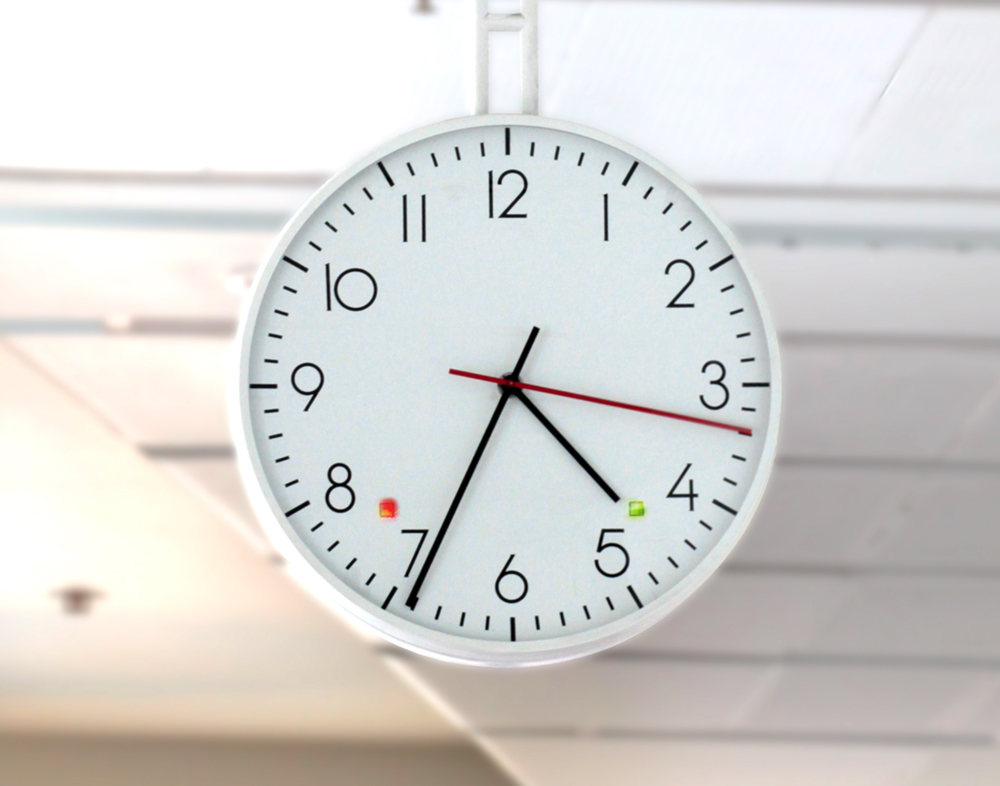
Parliamentary Education Office (peo.gov.au)
Description
The clocks at Australian Parliament House have red and green lights that indicate that the Senate or the House of Representatives bells are ringing. This happens to let senators and members of the House know when a vote is about to happen.
Copyright information
This work is licensed under a Creative Commons Attribution-NonCommercial-NoDerivs 3.0 Unported License.
You are free to share – to copy, distribute and transmit the work.
Attribution – you must attribute the work in the manner specified by the author or licensor (but not in any way that suggests that they endorse you or your use of the work).
Non-commercial – you may not use this work for commercial purposes.
No derivative works – you may not alter, transform, or build upon this work.
Waiver – any of the above conditions can be waived if you get permission from the copyright holder.
Cabinet Room
The Cabinet Room, Australian Parliament House
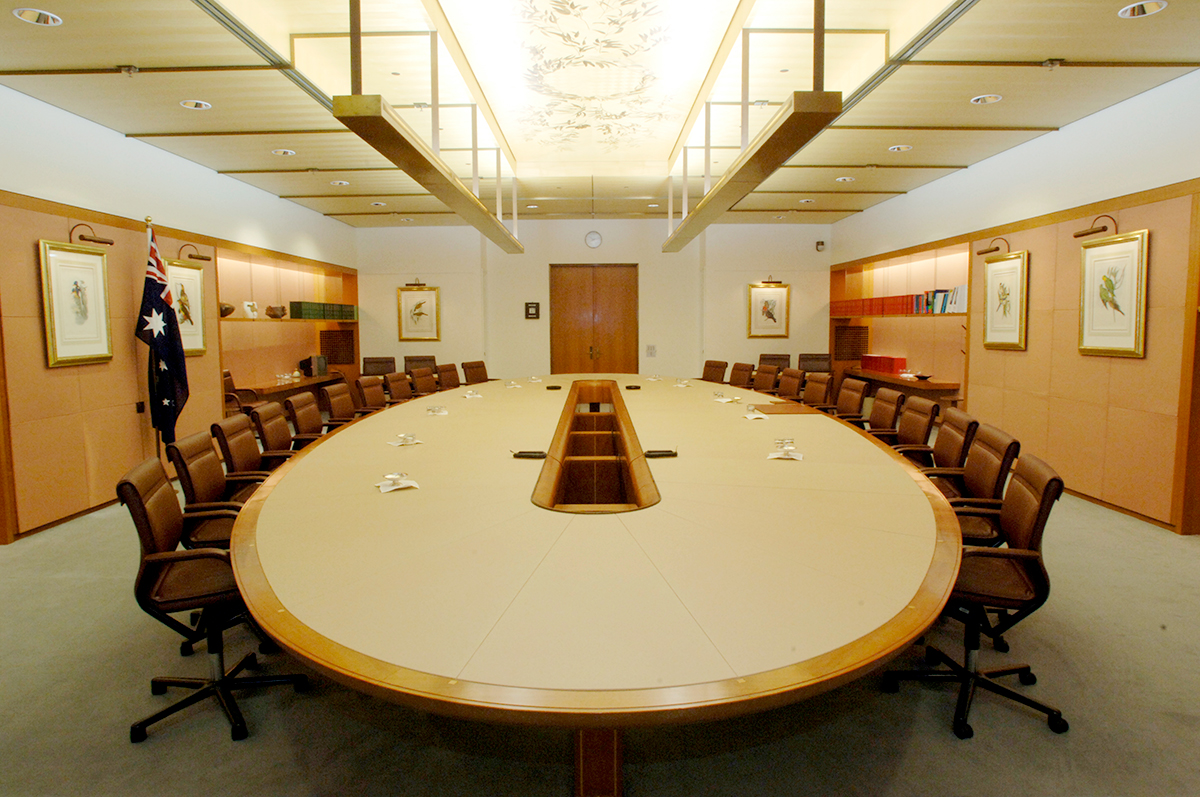
DPS Auspic
Description
This room, the Cabinet Room, is where the Prime Minister and senior ministers (the Cabinet) meet to make decisions for Australia. The Cabinet Room has a large oval-shaped table. There is space around the table for members of Cabinet to sit. Cabinet members discuss and make decisions about government policies in this space. Cabinet meetings are confidential.
Copyright information
Permission should be sought from DPS AUSPIC for third-party or commercial uses of this image. To contact DPS AUSPIC email: auspic@aph.gov.au or phone: 02 6277 3342.
While it is one of the few rooms in the building that has no natural light, the Cabinet Room does not resemble a bunker. Rather it has a simple 'leanness' that is intended to represent democracy. The architects compared the room, with its smooth, understated and elegant surfaces, to a large passenger ship.
The ceiling in the Cabinet Room is finished with timber marquetry panels inlaid with eucalypt leaves, which were designed by Adelaide artist Tony Bishop and made by craftsman Michael Retter. Hidden among the leaves is a cicada, a dragonfly and a blowfly. Despite these 'bugs', the room is highly secure and is regularly swept electronically because the Cabinet discuss confidential and secret matters which affect the nation. Tony Bishop believes his 'bugs' add a touch of Australian larrikinism and informality. He likes to imagine a minister in the debugged Cabinet Room 'looking at the ceiling, only to find that after all the effort there were still bugs there' (Weekend Australian, April 16 1988).
Committee rooms
Main Committee Room, Australian Parliament House
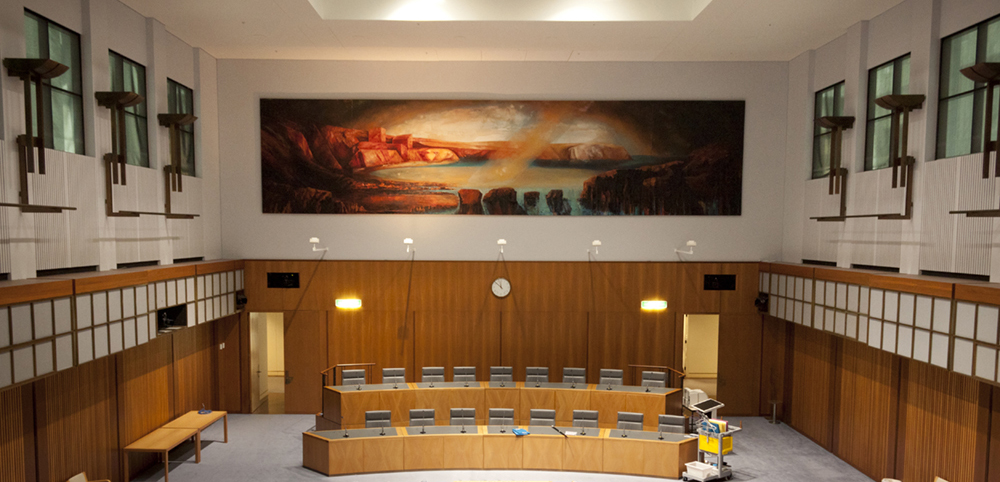
Parliamentary Education Office (peo.gov.au)
Description
This room, the Main Committee Room, is used for parliamentary committee hearings, public conferences and televised press conferences. It is the only area in the executive wing with a gallery that is open to the public.
In committee hearings, committee members sit in the two rows of seats on the raised platform facing the rest of the room. In these hearings, members of parliament examine proposed laws and issues in detail.
Copyright information
This work is licensed under a Creative Commons Attribution-NonCommercial-NoDerivs 3.0 Unported License.
You are free to share – to copy, distribute and transmit the work.
Attribution – you must attribute the work in the manner specified by the author or licensor (but not in any way that suggests that they endorse you or your use of the work).
Non-commercial – you may not use this work for commercial purposes.
No derivative works – you may not alter, transform, or build upon this work.
Waiver – any of the above conditions can be waived if you get permission from the copyright holder.
A Parliament for the people
'We built an example of democracy where the people who visit the place are as important as the politicians within.'
Richard Thorp, architect.
The Forecourt
The Forecourt, which is the main entrance to Parliament House, is designed to invite people into the building to observe the democratic process. A large open space, it is framed by 2 walls that appear to be outstretched as if in a gesture of welcome.
The Forecourt is paved with stone and red gravel, with a large ceremonial pool at its centre. In the centre of this pool is a granite mosaic created by Aboriginal artist Michael Nelson Jagamara, based on his painting Possum and Wallaby Dreaming. The mosaic measures 15 by 15 metres and is made up of 90,000 hand-guillotined granite pieces in 7 different colours. It sits on an island symbolising the Australian continent.
The mosaic depicts Jagamara's Dreaming – creation time – ancestors, including the brush-tail possum, red kangaroo, rock wallaby and goanna, gathering for an important ceremony. The tracks of these ancestors are shown moving toward concentric circles in the middle of the mosaic. Aboriginal peoples use Dreaming stories to pass on knowledge about their country, culture and laws.
Jagamara is a Warlpiri man from Papunya in the Western Desert region of Central Australia. The mosaic is based on the sand-painting tradition of the Warlpiri people.
The Great Verandah
The Great Verandah, Australian Parliament House
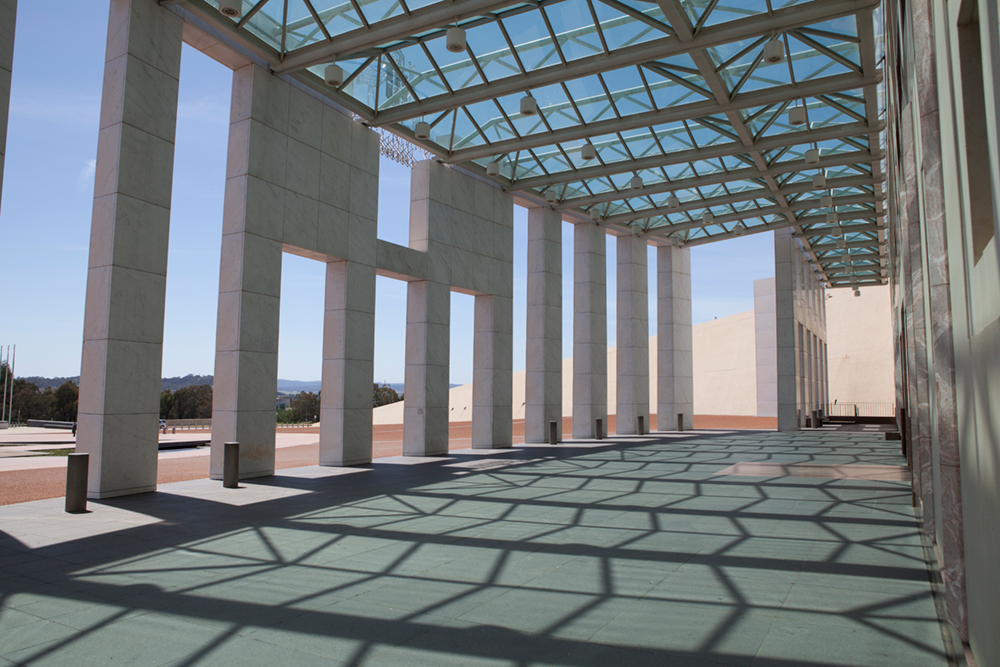
DPS AUSPIC
Description
The Great Verandah is one of the main features at the public entrance into Australian Parliament House. The Verandah is supported by a series of tall, rectangular columns, creating an open walkway. Above, a glass roof allows natural light to filter through, casting geometric shadows on the floor below.
Copyright information
Permission should be sought from DPS AUSPIC for third-party or commercial uses of this image. To contact DPS AUSPIC email: auspic@aph.gov.au or phone: 02 6277 3342.
The Great Verandah has a screen wall made up of 22 columns and is topped by a glazed glass roof. The screen wall is clad with slabs of Italian Carrara marble. Each of the 40 millimetre-thick slabs was cut from the same cliff face.
The Great Verandah pays tribute to the tradition of the verandah in Australian homes, which gives shelter from the sun and rain, and is where guests are welcomed and farewelled.
The white of the marble and the design of the screen wall recall the white façade of Old Parliament House with its series of oblong windows. This visual link is further emphasised when the 2 buildings are viewed together from the north and it appears that Old Parliament House sits within the curved walls of the new one.
A stainless steel coat of arms, created by Sydney sculptor, Robin Blau, is set into the Great Verandah. Measuring 4 by 4 metres, the work is based on 'rarrk' – crosshatching – a style of painting from Arnhem Land in the Northern Territory, which was developed many thousands of years ago. Like the Forecourt mosaic, it acknowledges the ongoing contribution of Aboriginal peoples in Australia. Blau also created a coat of arms for the executive wing entrance. Both works were a gift from the Parliament and the people of New South Wales.
The Foyer
With its marble surfaces and soft lighting, the Foyer is designed to be a cool and tranquil space in contrast to the open and often sun-drenched Forecourt. Natural light filters from windows and skylights through 48 columns clad in grey-green marble. The columns create an impression of spaces opening and closing, just as if walking through a forest. The forest of columns divides the Foyer into small bays in which people can assemble.
The floor is geometrically patterned in white marble and black limestone. The limestone, which is about 345 million years old, contains small marine fossils.
Two staircases, made from solid blocks of marble, lead from the Foyer to the first floor where the public has access to the House of Representatives and Senate.
The walls in the Foyer are topped by marquetry panels designed by Adelaide artist Tony Bishop and made by Sydney craftsman Michael Retter. The 20 coachwood timber panels are inlaid with designs of Australian flora. They include plants that are 200 million years old and species, such as wattle, waratah and eucalypts, noted by botanist Sir Joseph Banks in 1770. The panels on the north wall of the Foyer have an implicit link with the forecourt mosaic and depict plants used by Aboriginal peoples for food and medicine, such as yam, quandong and bunya pine.
Each of the coachwood panels is trimmed with jarrah. The flora inlays are made up of 5,000 pieces of timber which include Queensland walnut, poplar, kauri pine, camphor laurel and Australian red cedar. For the architects, the panels symbolised 'the unknown exotic land to which the colony had come as well as the proximity of this space [the Foyer] to the outdoors.'
The Marble Foyer, Australian Parliament House
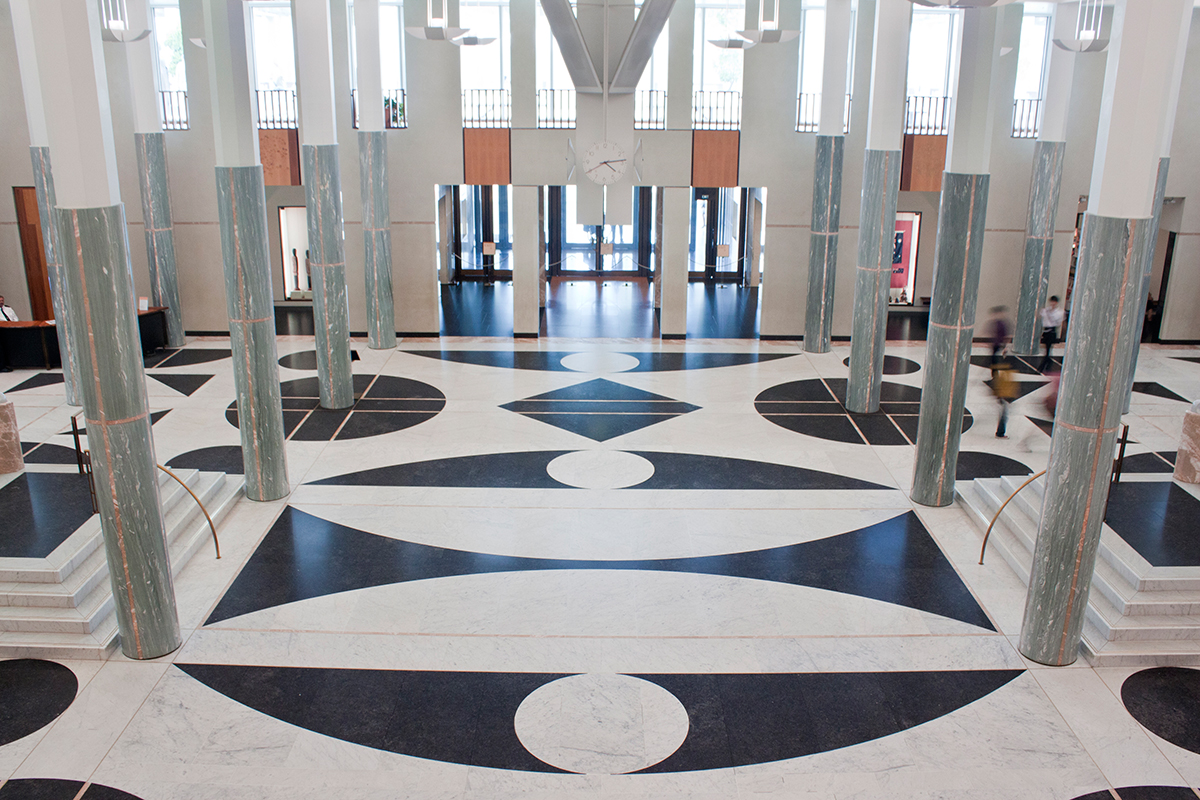
Parliamentary Education Office (peo.gov.au)
Description
The Foyer of Australian Parliament House is the main public entrance into the building. It serves as a gathering and orientation space for visitors including school groups, tourists, and official guests. It features floors made of black and white marble in a geometric pattern of circles, triangles and squares. There are also several tall green marble columns spaced evenly throughout the Foyer.
Copyright information
This work is licensed under a Creative Commons Attribution-NonCommercial-NoDerivs 3.0 Unported License.
You are free to share – to copy, distribute and transmit the work.
Attribution – you must attribute the work in the manner specified by the author or licensor (but not in any way that suggests that they endorse you or your use of the work).
Non-commercial – you may not use this work for commercial purposes.
No derivative works – you may not alter, transform, or build upon this work.
Waiver – any of the above conditions can be waived if you get permission from the copyright holder.
The Great Hall
The Great Hall, Australian Parliament House
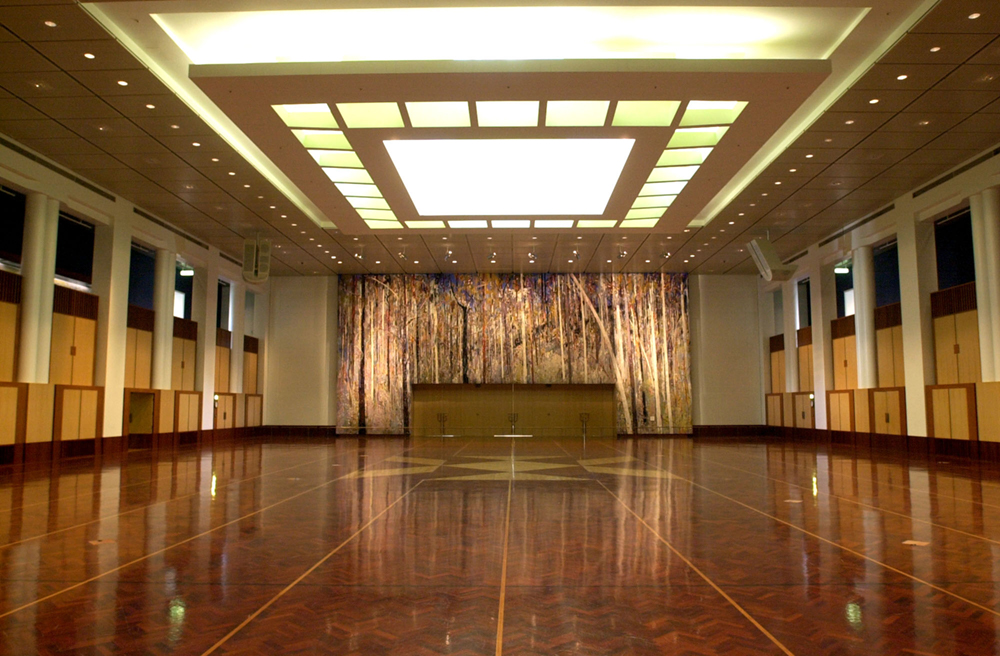
DPS AUSPIC
Description
The Great Hall of Australian Parliament House features a large tapestry based on a pointing by Arthur Byod at the end of the room. The Great Hall is used for major national events like the opening of Parliament, award ceremonies and official dinners.
Copyright information
Permission should be sought from DPS AUSPIC for third-party or commercial uses of this image. To contact DPS AUSPIC email: auspic@aph.gov.au or phone: 02 6277 3342.
The centrepiece of the Great Hall is a tapestry based on a painting by Australian artist Arthur Boyd, of a dense eucalyptus forest in the Shoalhaven area of New South Wales. By depicting a detailed section of the forest rather than a panoramic view, Boyd gives the impression the landscape has no beginning or end. This suggests connections with the landscape around Parliament House and throughout Australia.
The tapestry, which measures 20 metres wide by 9 metres high, was woven by the Victorian Tapestry Workshop, who worked closely with Boyd to interpret his design. Fourteen weavers spent nearly 2 years making the tapestry in 4 separate panels. On average, each weaver completed one square metre every 5 weeks. Boyd's original painting is on permanent display at Parliament House.
The Members Hall
The Members Hall is a ceremonial space at the heart of the building. It is also an informal meeting place for members of parliament. In the centre of the hall is a reflective pool made from a single piece of South Australian Black Imperial granite. It is 3.5 metres squared by 250 millimeters thick and weighs 8 tonnes. The pool reflects the flag above. The sound of water trickling through the pool prevents the conversations of members of parliament from being overheard.
Art in Parliament House
Parliament House has a large collection of Australian art, including more than 60 major works commissioned for the building. The architects worked with artists and craftspeople in the early stages of the design process to integrate the works of art with the architecture. According to the Parliament House Construction Authority, 'works of art and craft were to be understood as "voices" within the building capable of expressing the diverse character and identity of Australia ... the presence of the works was a critical aspect of creating a sense of resonance in the building with past cultural tradition'.
Today, the Parliament House Art Collection is made up of over 6,500 works of art and heritage objects. The collection includes works of art by major Australian artists and is an important representation of the nation's artistic expression. Many of the artworks are rotated around various locations within the building.
The flag
Australian Parliament House flag mast and flag
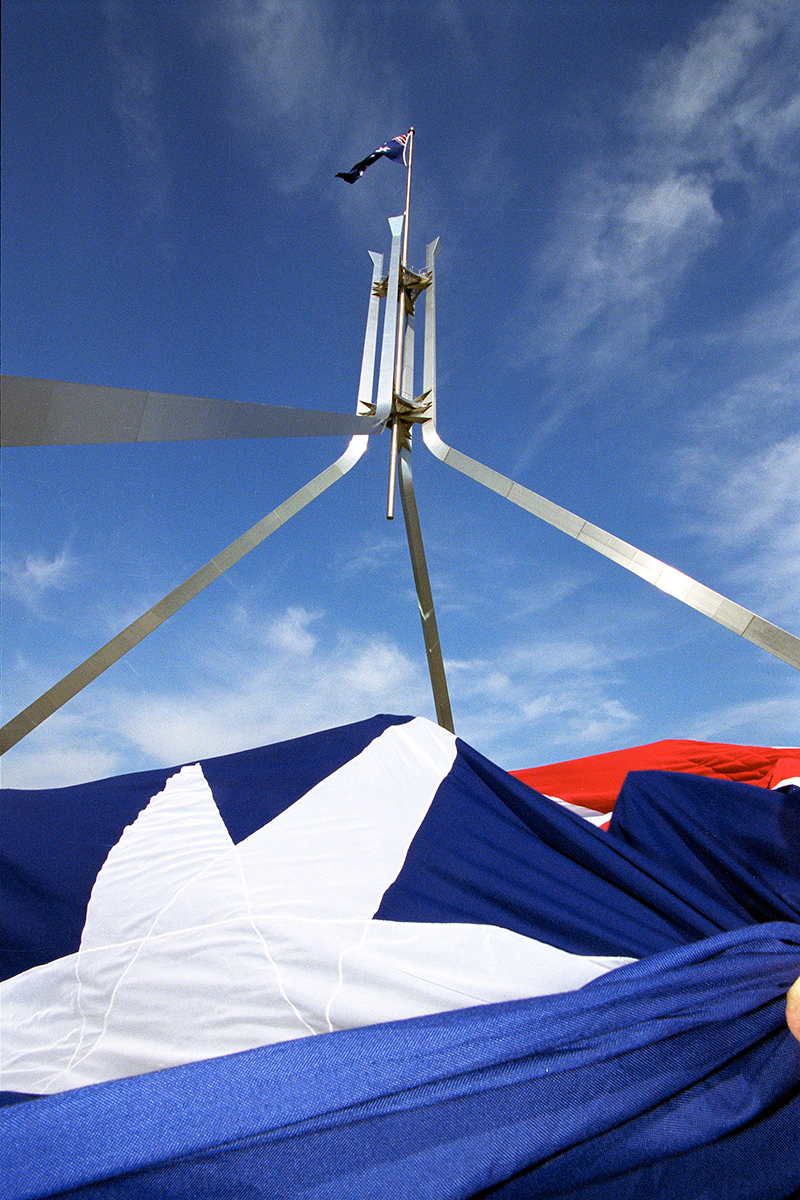
DPS Auspic
Description
The flag mast above Australian Parliament House has 4, angled, stainless-steel legs, forming a pyramid-like shape. The legs are anchored into the roof above the centre of Parliament House. The flag mast rises 81 metres high and flies the Australia flag above Parliament House 24 hours a day. This photo shows a second Australian flag in the foreground.
Copyright information
Permission should be sought from DPS AUSPIC for third-party or commercial uses of this image. To contact DPS AUSPIC email: auspic@aph.gov.au or phone: 02 6277 3342.
Perhaps the most identifiable symbol of Parliament House is the distinctive flagmast and flag. The Australian flag, which is flown over Parliament House 24 hours a day, 7 days a week, marks the exact centre of the building. The flag is about the size of the side of a double-decker bus, measuring 12.8 metres by 6.4 metres. The flagmast is 81 metres high and weighs 220 tonnes, making it one of the largest stainless steel structures in the world.
The flag is changed every 4 to 6 weeks. Fourteen flags are rotated regularly so they wear evenly. It takes 3 people to raise and lower the flag. A hydraulically-operated cage called the Alimak is used to transport 2 people 60 metres up the flagmast to a platform, while below one person controls the winches used during the operation. The Alimak doesn't remain vertical for the whole journey, but follows the 45 degree angle of the flagpole, which means the occupants spend part of the journey almost lying down. For safety reasons, the flag can't be changed if it is too windy or stormy.
Curriculum alignment
Year 6 AC9HS6K06
